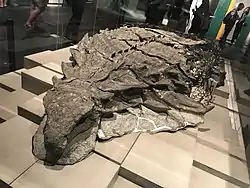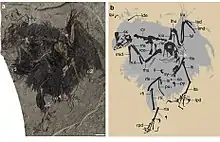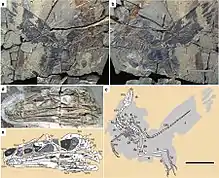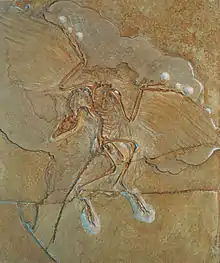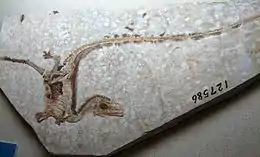List of dinosaur specimens with preserved soft tissue
There have been some discoveries of unusually well-preserved fossil dinosaur specimens which bear remnants of tissues and bodily structures. Such tissue usually decays too quickly to enter the fossil record, unlike more durable bones and teeth.
Ornithischians
Basal Ornithischians
| Nickname | Catalogue Number(s) | Institution(s) | Taxon | Age | Unit | Country(s) | Notes | Images |
|---|---|---|---|---|---|---|---|---|
|
Institute of Natural Resources, Ecology, and Cryology |
A basal Ornithischian that preserves protofeathers. |
|
Hadrosaurs
| Nickname | Catalogue Number(s) | Institution(s) | Taxon | Age | Unit | Country(s) | Notes | Images |
|---|---|---|---|---|---|---|---|---|
|
MRF-03 |
Marmarth Research Foundation |
 Impression of "Dakota"'s skin | ||||||
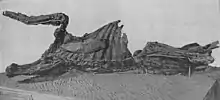 The "Trachodon mummy" | ||||||||
Ceratopsians
| Nickname | Catalogue Number(s) | Institution(s) | Taxon | Age | Unit | Country(s) | Notes | Images |
|---|---|---|---|---|---|---|---|---|
|
SMF R 4970 |
Psittacosaurus sp. |
This animal displays pigment preservation, bristles as well as a preserved Cloaca. |
|
Thyreophorans
| Nickname | Catalogue Number(s) | Institution(s) | Taxon | Age | Unit | Country(s) | Notes | Images |
|---|---|---|---|---|---|---|---|---|
|
Suncor Nodosaur |
TMP 2011.033. 0001 |
This animal displays pigment preservation, as well as keratinous sheaths and stomach contents. |
|
Theropods
Maniraptoriformes
| Nickname | Catalogue Number(s) | Institution(s) | Taxon | Age | Unit | Country(s) | Notes | Images |
|---|---|---|---|---|---|---|---|---|
|
IVPP V14378, LPM – B00 169, and BMNHC PH828 |
Institute of Vertebrate Paleontology and Paleoanthropology, Liaoning Paleontological Museum, and the Beijing Museum of Natural History |
Many specimens of Anchiornis have been found, but a majority have not been described |
| |||||
|
IVPP 21711 |
It is a small Enantiornithine bird, it preserves pigment |
| ||||||
|
PMoL-B00175 |
the Paleontological Museum of Liaoning |
The small bird possess pigments that might indicate black and iridescent colors. |
| |||||
|
MUSM 1444 |
Otuma Formation |
A Fossil Penguin, pigments are preserved on this specimen. |
||||||
|
British Museum, the Maxburg Museum, among others |
| |||||||
|
Natural History Museum, Berlin and the Wyoming Dinosaur Center |
| |||||||
|
UFrJ-Dg 031 |
Cratoavis cearensis |
It is a small Enantiornithine bird, it preserves a pygostyle and body feathers. |
Compsognathidae
| Nickname | Catalogue Number(s) | Institution(s) | Taxon | Age | Unit | Country(s) | Notes | Images |
|---|---|---|---|---|---|---|---|---|
|
GMV 2123 and it's counter slab, NIGP 127587, and D 2141 |
Geologic Museum of China, Nanjing Institute of Geology and Palaeontology, and the Dalian Natural History Museum |
Three Specimens of Sinosauropteryx have been discovered to date, coloration is know from this dinosaur. |
| |||||
|
JMP-V-05-8-01 and CAGS-IG-T1 |
Preserves extensive protofeathers on the body and tail |
| ||||||
|
SMNK PAL 29241 |
The specimen is controversial in it legality, and it possesses feather “spikes” on its shoulders |


